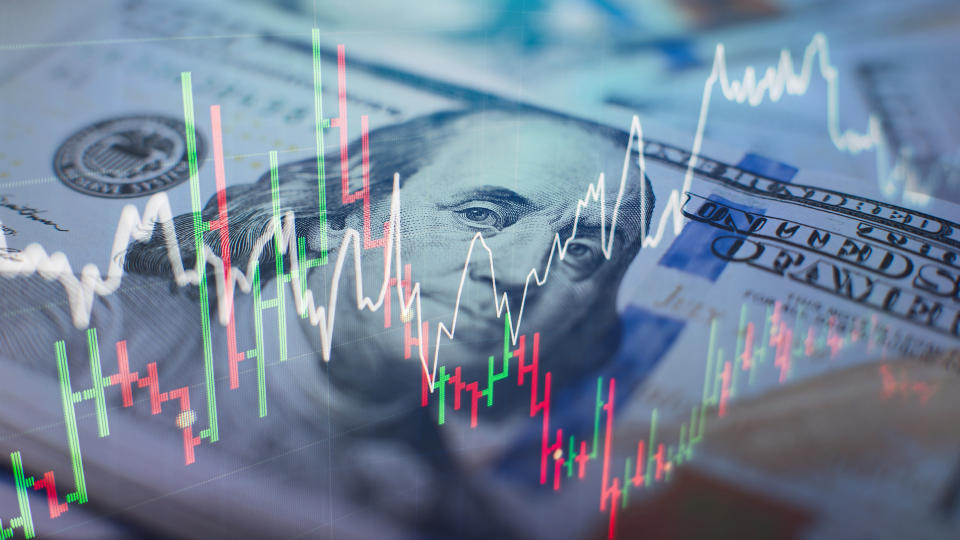Economic Indicators (and Which Matter for a Recession)

The National Bureau of Economic Research (NBER) defines a recession as “a significant decline in economic activity spread across the economy, lasting more than a few months.” The decline would normally be visible in real GDP, real income, employment, industrial production, and wholesale-retail sales.
See Our List: 100 Most Influential Money Experts
Next: How To Invest In Precious Metals To Protect Your Retirement
Food Stamps: What Is the Maximum SNAP EBT Benefit for 2023?
Economists rely on economic indicators to reveal when all those things are happening at the same time — which they are right now or will be soon, according to some analysts. Here’s what you need to know.
Economic Indicators Can Help You Predict and Prepare
Economic indicators are data sets that help analysts and investors understand what has happened or what might happen in some segment of the economy.
Lagging economic indicators chronicle trends that have already happened. Examples include the unemployment rate and corporate profit reports — by the time you hear about them, the jobs and profits have already been gained or lost.
Leading economic indicators often precede major economic events, so economists use them to try to predict what the economy might do in the future. Business inventory levels, for example, can reveal whether demand for certain products is high enough or low enough to cause the economy to expand or contract.
Economists rely on many economic indicators to predict recessions. The following are the most important of the bunch.
Take Our Poll: Are You In Favor of More Inflation Relief in 2023?
Treasury Yield Curve
No formula for predicting recessions is foolproof, but historically speaking, the yield curve has a better track record than all the rest, according to Forbes. U.S. Treasuries with longer maturities usually pay higher yields, but on rare occasions, short-term bonds pay higher yields than long-term bonds.
That only happens when the market is pessimistic about the economy’s long-term prospects. When it does, it’s called an inverted yield curve because the graphs that illustrate changing interest rates slope downward instead of upward.
Although there have been false positives where the yield curve inverts without a recession, and recessions have occurred without an inverted yield curve signaling a warning beforehand, when the yield curve inverts, a recession is rarely far behind.
Unemployment Rate
Rising unemployment is one of the classic hallmarks of a recession. That’s because recession perpetuates unemployment and vice versa.
When a recession sets in, unemployment rises as demand and output decrease. With fewer businesses hiring, more and more unemployed people have to compete for fewer and fewer jobs, which keeps them out of work longer and with less money to spend. As they spend less, demand for products and services falls, which forces businesses to lay off even more workers, and the cycle continues.
According to the St. Louis Fed, the Sahm Rule Recession Indicator signals the start of a recession when the three-month moving average of the national unemployment rate rises by 0.50 percentage points or more relative to its low during the previous 12 months.
Gross Domestic Product
According to Forbes, two consecutive quarters of declining GDP has been the “common standard” for the start of a recession since economist Julius Shiskin coined the rule in 1974. A healthy economy steadily expands, and while one bad quarter can be a fluke, two straight quarters of declining productivity indicates a serious underlying problem.
Durable Goods Orders
Durable goods are manufactured products that are designed to last three years or more, like vehicles, washing machines and furniture. According to the U.S. Census Bureau, which tracks and reports durable goods orders, the metric is an important indicator of the health of the manufacturing sector and therefore the health of the overall economy.
When things are going well and people are optimistic about the economy’s long-term prospects, consumers are more likely to make expensive big-ticket purchases. Similarly, businesses are more likely to invest in durable goods like machines, vehicles and computer technology when the economy is expanding and business is booming.
Consumer Spending
The Bureau of Economic Analysis (BEA) tracks consumer spending, which just might be the most reliable economic indicator of them all. Consumer spending, after all, impacts virtually every element of a recession, including:
Gross domestic product: Consumer spending accounts for two-thirds of America’s GDP, and as previously discussed, a declining GDP is a telltale sign of a recession.
Employment: When consumer spending rises, businesses hire more workers to meet the growing demand.
Durable goods: When increased consumer spending boosts demand, businesses make investments in things like durable goods to expand or refine their operations so they can keep up.
Income: As per the NBER’s definition, personal income is a key factor in a recession. When incomes rise or fall, consumer spending tends to follow suit.
Consumer confidence: Consumer spending is a reflection of consumer confidence, which is one of the most important sentiment indicators when a recession is near.
More From GOBankingRates
This article originally appeared on GOBankingRates.com: Economic Indicators (and Which Matter for a Recession)

 Yahoo Movies
Yahoo Movies 